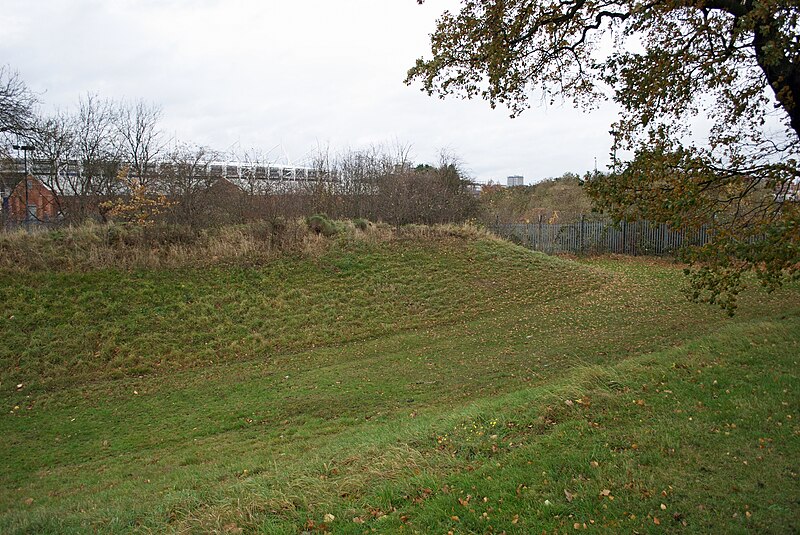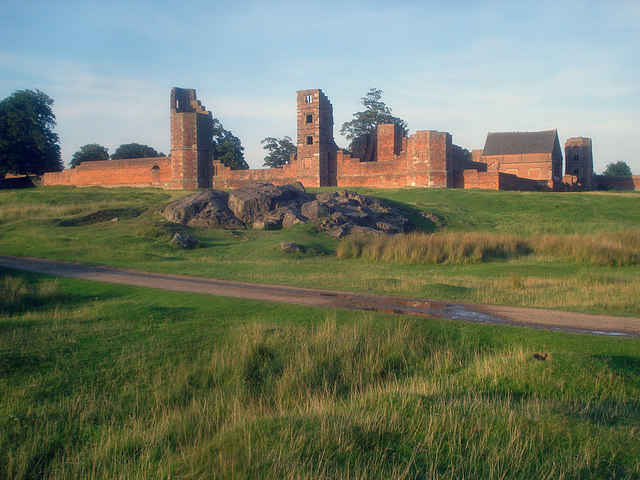As regular followers of this blog might have noticed, I've relished being a Leicestrian living in York over the last couple of years, with all the Greyfriars Dicky nonsense.
I'm no monarchist - far from it - but I'm glad that the body in the car park really was Richard the Third, and that Leicester will get to keep it. York is kingly enough; it needs no more mediaeval money-spinners. Leicester's history is much more obscure, and a regal tourist attraction might just enable visitors to start scratching that surface.
This week, the genetic analysis of the Greyfriars skeleton was published, proving beyond reasonable doubt that it was Richard III. However, the study threw up what the BBC described as an 'infidelity surprise'. Surviving members of his paternal lineage have different DNA to Dicky's, suggesting that a spot of cuckoldry had taken place.
Kings and queens shagging around doesn't really count as a surprise to me; if we didn't know it already, we could certainly have guessed. What I did find interesting, though, was the discovery that - if the Tudor (or indeed Plantagenet) legitimacy was cast into doubt - the two main alternative lineages still bring royalty back to Leicester.
If you accept Henry Tudor (Henry VII)'s claim to the throne, then the first of these is that of Teresa Freeman-Grenville, Lady Kinloss. She is the many, many times great-grand-daughter of Lady Catherine Grey, who was born in Bradgate House, just northwest of Leicester, in August 1540.
Catherine was the sister of Lady Jane Grey, Leicester's own 9-day queen. Henry VII was their maternal great-grandfather, and when his grandson Edward VI realized he was dying, he named his cousin Jane as his successor.
Of course, as soon as Edward died, other forces came into play, and Jane was swiftly imprisoned and then executed. Mary I became Queen of England, and after her Elizabeth I, but as neither bore children, Henry VIII had no direct heirs. Under the terms of his will, the Greys were next in line, and with Catherine also deceased, her claim to the throne passed to her son, Edward Seymour.
Perhaps unsurprisingly, given the times, he was regarded by many as illegitimate, and did not become king. However, he had a strong claim, and he was definitely a son of a Leicestrian. So, rather than just being some evocative ruins in a pleasant country park, Bradgate House should be recognized as a British royal palace.
Now, if you regard Edward Seymour as a dubious would-be king, that's fine. No-one much seems to be making too much of a fuss about it. Rather more assertive is the argument - made by TV's Tony Robinson, no less - that Richard III's brother, Edward IV, was illegitimate.
If that were true, his brother George, Duke of Clarence, should have become king instead. Henry Tudor wouldn't have bothered marrying Edward's daughter Elizabeth, and the Battle of Bosworth wouldn't have happened. Richard III wouldn't have ended up in a Leicester car park.
No, instead, Leicestershire would be enjoying huge numbers of tourist visits for different reasons: its two royal castles at Ashby-de-la-Zouch and Kirby Muxloe. For these were the homes of the Hastings, and the Hastings were (indeed, still are) George, Duke of Clarence's direct descendants.
As with Bradgate House, the two castles are not now in the best condition. Kirby Muxloe never really got properly built, thanks to its architect, William, 1st Baron Hastings, being executed by Richard III shortly after he took over kinging in 1483. Ashby Castle fared a bit better, and the Hastings clan continued to live there, having returned to favour during the reign of Henry VIII.
Backing the wrong side in the Civil War saw the castle surrendered and mostly demolished, but the true kings and queens of England stayed in town, right up till the early 21st Century. They then relocated to Australia, but that's just an inconvenient truth in my Leicestrocentric tale. I'm sure they'd have stayed in Ashby if they'd been raking in the tourist pounds.
Whichever way you look at it, and whatever you think about Greyfriars Dicky, Leicestershire is absolutely central to the story of England. If you don't believe me, just ask Michael Wood.
If the City of Leicester authorities aren't able to use Richard III to tap into all this, well, then they really aren't up to much.
I'm no monarchist - far from it - but I'm glad that the body in the car park really was Richard the Third, and that Leicester will get to keep it. York is kingly enough; it needs no more mediaeval money-spinners. Leicester's history is much more obscure, and a regal tourist attraction might just enable visitors to start scratching that surface.
 |
| Raw Dykes, near the King Power Stadium. Don't scratch the surface here, it's an enigmatic scheduled ancient monument! |
This week, the genetic analysis of the Greyfriars skeleton was published, proving beyond reasonable doubt that it was Richard III. However, the study threw up what the BBC described as an 'infidelity surprise'. Surviving members of his paternal lineage have different DNA to Dicky's, suggesting that a spot of cuckoldry had taken place.
Kings and queens shagging around doesn't really count as a surprise to me; if we didn't know it already, we could certainly have guessed. What I did find interesting, though, was the discovery that - if the Tudor (or indeed Plantagenet) legitimacy was cast into doubt - the two main alternative lineages still bring royalty back to Leicester.
If you accept Henry Tudor (Henry VII)'s claim to the throne, then the first of these is that of Teresa Freeman-Grenville, Lady Kinloss. She is the many, many times great-grand-daughter of Lady Catherine Grey, who was born in Bradgate House, just northwest of Leicester, in August 1540.
Catherine was the sister of Lady Jane Grey, Leicester's own 9-day queen. Henry VII was their maternal great-grandfather, and when his grandson Edward VI realized he was dying, he named his cousin Jane as his successor.
Of course, as soon as Edward died, other forces came into play, and Jane was swiftly imprisoned and then executed. Mary I became Queen of England, and after her Elizabeth I, but as neither bore children, Henry VIII had no direct heirs. Under the terms of his will, the Greys were next in line, and with Catherine also deceased, her claim to the throne passed to her son, Edward Seymour.
Perhaps unsurprisingly, given the times, he was regarded by many as illegitimate, and did not become king. However, he had a strong claim, and he was definitely a son of a Leicestrian. So, rather than just being some evocative ruins in a pleasant country park, Bradgate House should be recognized as a British royal palace.
 |
| Home of the true Queens of England. (From Geograph) |
Now, if you regard Edward Seymour as a dubious would-be king, that's fine. No-one much seems to be making too much of a fuss about it. Rather more assertive is the argument - made by TV's Tony Robinson, no less - that Richard III's brother, Edward IV, was illegitimate.
If that were true, his brother George, Duke of Clarence, should have become king instead. Henry Tudor wouldn't have bothered marrying Edward's daughter Elizabeth, and the Battle of Bosworth wouldn't have happened. Richard III wouldn't have ended up in a Leicester car park.
No, instead, Leicestershire would be enjoying huge numbers of tourist visits for different reasons: its two royal castles at Ashby-de-la-Zouch and Kirby Muxloe. For these were the homes of the Hastings, and the Hastings were (indeed, still are) George, Duke of Clarence's direct descendants.
 |
| Kirby Muxloe Castle (from Wikimedia Commons). Much nicer than Buckingham Palace, and I don't say this because I was born just down the road, honest guv. |
As with Bradgate House, the two castles are not now in the best condition. Kirby Muxloe never really got properly built, thanks to its architect, William, 1st Baron Hastings, being executed by Richard III shortly after he took over kinging in 1483. Ashby Castle fared a bit better, and the Hastings clan continued to live there, having returned to favour during the reign of Henry VIII.
Backing the wrong side in the Civil War saw the castle surrendered and mostly demolished, but the true kings and queens of England stayed in town, right up till the early 21st Century. They then relocated to Australia, but that's just an inconvenient truth in my Leicestrocentric tale. I'm sure they'd have stayed in Ashby if they'd been raking in the tourist pounds.
Whichever way you look at it, and whatever you think about Greyfriars Dicky, Leicestershire is absolutely central to the story of England. If you don't believe me, just ask Michael Wood.
If the City of Leicester authorities aren't able to use Richard III to tap into all this, well, then they really aren't up to much.

Comments